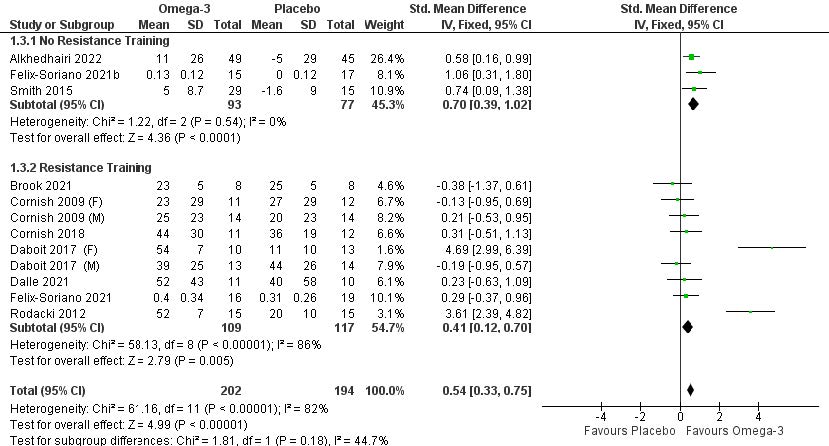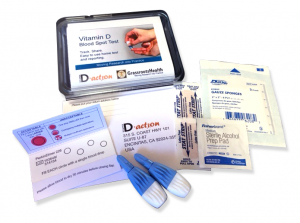Published on June 6, 2022
Meta-analysis shows that omega-3 supplementation improves lower body strength and functional performance scores for tests that are important predictors of functional ability in older age
Key Points
- Specific outcomes in studies among those supplementing with omega-3 fish oils and/or with a higher Omega-3 Index include the prevention of loss of muscle strength, decreased ROM, and delayed onset muscle soreness (DOMS), as well as increased upper arm circumference and decreased muscle echo intensity (an indicator of muscle quality)
- A systematic review and meta-analysis by Cornish et al. looked at 16 different studies on the effect of omega-3 fatty acids (with or without resistance exercise training) on muscle mass and function in older adults and found significant improvement of lower body strength, improved performance in the timed up and go test, and improved performance in the 30 second sit-to-stand test among those omega-3 supplements
- Measuring the Omega-3 Index level is essential, as there is a large amount of variability in the omega-3 status for different people with the same intake amount (similar to vitamin D!); for example, a GrassrootsHealth analysis showed that the range of response with 1000 mg of EPA+DHA per day was 5.7% to 10.2%. It is recommended that individuals measure their Omega-3 Index and determine a personalized dose using the Omega-3 calculator to achieve a minimum Omega-3 Index of 8%.

Studies have shown how omega-3 supplementation and a higher Omega-3 Index can positively impact muscle strength, athletic performance, and recovery. Muscle stiffness, soreness, and loss of range of motion (ROM) have all been shown to be reduced or prevented with fish oil supplements. Specific outcomes among those supplementing with omega-3 fish oils and/or with a higher Omega-3 Index include the prevention of loss of muscle strength, decreased ROM, and delayed onset muscle soreness (DOMS), as well as increased upper arm circumference and decreased muscle echo intensity (an indicator of muscle quality).
A slightly different yet common concern when it comes to muscle strength and aging is sarcopenia, which is the age-related loss of muscle mass and strength among older adults. This condition can result in reduced functionality and a greater risk of falls, and has been related to metabolic syndrome and chronic, low-grade inflammation. Studies, such as those included in the review below, are now showing that omega-3 supplementation may help with this musculoskeletal condition as well.
Omega-3s Shown to Improve Lower Body Strength and Performance in Older Adults
A systematic review and meta-analysis by Cornish et al. looked at 16 different studies on the effect of omega-3 fatty acids (with or without resistance exercise training) on muscle mass and function in older adults. 15 of the studies were randomized controlled trials, and one was a randomized, non-controlled trial. In all, 2438 participants were included (1660 females and 778 males), ages 55 years and older, were included in the analysis. Omega-3 supplementation used in the trials was mostly fish oil or fish oil derived products, while one used krill oil and one used flax oil. Supplementation doses varied widely.
The combined data showed that omega-3 supplementation
- resulted in significant improvement of lower body strength (without residual exercise training; p<0.001)
- improved performance in the timed up and go test (reduced time; p<0.001)
- improved performance in the 30 second sit-to-stand test (p<0.001)
- no significant effect was found for omega-3 supplementation and upper body strength or for walking speed
The chart below is a forest plot showing the impact of omega-3 supplementation on lower body strength among each of the studies analyzed.

A forest plot is often used in a meta-analysis to help compare two things for one outcome, in this case, placebo versus omega-3 supplementation for their impact on lower body strength. The points to the right of the vertical ‘0’ line represent the studies whose results showed a benefit for lower body strength among the omega-3 supplementation groups. Each point has an associated bar with it – this represents the 95% confidence interval used in statistics. In reality it means the point could be anywhere along that line. Finally the big diamonds show the aggregate risk for all of the studies in each sub-group and in total.
In this plot, most points are to the right, showing the majority of studies in the review demonstrated a favorable effect of omega-3 supplementation on lower body strength.
Make Sure You Are Getting Enough Omega-3s
Have you measured your Omega-3 Index? Scientists recommend a target Omega-3 Index of 8% or higher. Testing is essential, as there is a large amount of variability in the omega-3 status for different people with the same intake amount (similar to vitamin D!). For example, a GrassrootsHealth analysis showed that the range of response with 1000 mg of EPA+DHA per day was 5.7% to 10.2%. Therefore, it is recommended that individuals measure their Omega-3 Index and determine a personalized dose using the Omega-3 calculator to achieve a minimum Omega-3 Index of 8%.
Measure Your Omega-3 Index Along with Your Vitamin D!
 Having and maintaining healthy vitamin D, omega-3s, and other nutrient levels can help improve your health now and for your future. Choose which to measure, such as your vitamin D, omega-3s, and essential minerals including magnesium and zinc, by creating your custom home test kit today. Take steps to improve the status of each of these measurements to benefit your overall health. With measurement you can then determine how much is needed and steps to achieve your goals. You can also track your own intakes, symptoms and results to see what works best for YOU.
Having and maintaining healthy vitamin D, omega-3s, and other nutrient levels can help improve your health now and for your future. Choose which to measure, such as your vitamin D, omega-3s, and essential minerals including magnesium and zinc, by creating your custom home test kit today. Take steps to improve the status of each of these measurements to benefit your overall health. With measurement you can then determine how much is needed and steps to achieve your goals. You can also track your own intakes, symptoms and results to see what works best for YOU.
Enroll in D*action and Test Your Levels Today!





